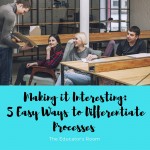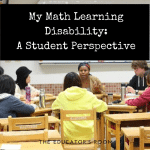Overview:
When working with students you have to start with empathy in order to differentiate for learning.
Differentiation: For less than $20 an hour, I was regularly – to name a few – choked, bitten, spit on, and scratched, yet any time the words “Long-Term Substitute” were followed by “SPED” or “Emotionally Disturbed” (the diction used at the time), I accepted the position as quickly as the slowly-loading website would allow. As the buffering arrows danced on my screen, anxiety would convince me that someone else might take the job before I could – a hilarious and illogical fear, considering that the other substitutes were terrified of these classrooms. I couldn’t wrap my mind around the idea that these gigs were not everyone else’s first choice, too; I always imagined dozens of substitute teachers – with much better wifi than I – jumping at the opportunity to work with these kiddos like I was.
See, these kids were just like me. Just because I haven’t had the opportunity to sink my teeth into anyone lately doesn’t mean I can’t fully empathize with the urge to – well – express my frustration and anxiety in sometimes. . . unproductive ways. Because, really, that’s all they’re searching for – a way to communicate their feelings in spite of their obstacles with verbal communication.
Overstimulation and Differentiation
When my Nonverbal, Autistic student was overstimulated by classroom noise, he’d scream and start pushing us. He wasn’t angry, defiant, or aggressive; he just needed our help and expressed it in a way that he knew how. At the start of my teaching career, I can count dozens of times when I’ve been overstimulated and ended up allowing my frustration to permeate through my tone. Though wrong of me to do so, at the time, it was the only way I knew how.
What about the teenager in the Learning Center, who (on my first day) punched the window open and evaded administration while he bled from his hand? He’d been misjudged by educators for a decade. He didn’t have a “SPED” label, so his outbursts must be outright defiance, right? Fast forward. They later realized he had a benign tumor pushing on the parts of his brain that regulate emotion. Would he have been treated differently his entire life if his educators knew the whole story?
Learning unconditional empathy for these students forever shaped how I would approach every student after them – even as I went on to teach English in General Education classrooms. Substituting in SPED and ED challenged me to differentiate not only my instruction but my interactions with students.
It was the best damn job I’ve ever had.
Why Differentiated Interactions also Matter in General Education
“Absolute shock” – that’s how I would describe my Gen Ed students’ expressions as I walked up to the whiteboard and crossed out Ruth’s sweet note on the whiteboard that said, “Mrs. I. gave me an A.” Ruth was a foster child with an unimaginable past, and the hybrid nature of COVID-style classrooms was making her feel even more isolated and unmotivated. A few of her teachers mistook her mindset as defiance and tried their best to help her by laying down the law; despite their best intentions, they drove her even further away from a desire to learn – not to mention from learning how to trust an adult again.
After my experience in SPED and Emotionally Disturbed classrooms, I knew her grades did not define her identity, intelligence, or ability. Even more importantly, I knew that her “attitude” was not a reflection of disrespect; rather, it was an indicator that there was more to her story. Even if she didn’t have a label or a tangible explanation like a tumor, the trauma from her past mattered, and I’d have to be okay with trusting that her story calls for differentiation – even if I never knew her full story.
Instead of returning her “defiance” with discipline and annoyance, I made an effort to ask her about how she was feeling, talk to her about her hobbies, and – most effectively – offer her lots of snacks. Ruth soon perceived that I saw her as a being with a purpose and not just another statistic or grade to raise. She needed a teacher to adjust the teaching process and create an environment where she felt safe to learn.
Examples of Differentiation
At times, differentiation looked like allowing her to put her own spin on project to give her a chance to express herself in a way that felt good; other times, this looked like accepting a late assignment for full credit or giving her five minutes to get started on her lesson before going over to badger her about why she hasn’t started yet. (Turns out, she was a lot more likely to start on her own if I didn’t give her reason not to.) The more I gave her grace and empathy, the more I supported her emotional capacity to be vulnerable enough to try.
Differentiation doesn’t start in the classroom; it starts within the educator. It starts with us having the discernment to see that a student’s behavior is not something to be taken personally. Whether it be as traumatic as being choked in a bathroom – like I was – or as trivial (yet infuriating) as an eye roll, these behaviors are just that: behaviors. They are merely side effects of a child’s story, and when we unshakably strive toward empathy-driven differentiation, we empower them to rewrite the ending.
Ruth was failing my class at the beginning of the semester. Come summer, when I crossed out her note on the whiteboard, it looked something like this:
Mrs. I. gave me an A.
Ruth earned an A.

Rayna Ibarra is an entrepreneur and educator. She advocates for inclusion, differentiation, and social-emotional support for all students. Outside of work, she is a toddler mom and wife to her best friend of 11 years.





